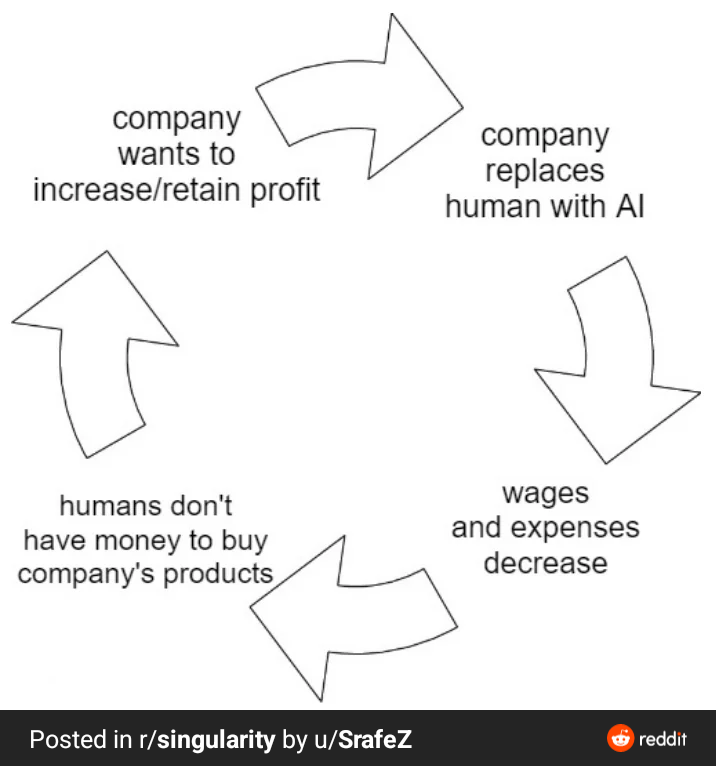AI leads to spiral into depression?
June 25, 2023One possible outcome to AI is an economic spiral that results from AI improving company efficiency leading to employee layoffs leading to fewer customers for company products.
I came across this graphic on Reddit and thought it described the situation well.

I think ChatGPT is a bit too optimistic but I decided to start with a draft with its text and then edit it to be more pessimistic.
Artificial Intelligence (AI) and automation have the capacity to disrupt the fabric of global economies, yielding both positive and negative outcomes. On the positive side, AI can generate tremendous gains in efficiency, productivity, and competitiveness. On the negative side, these improvements could lead to employee layoffs, with consequent shrinking of the consumer base, leading to an economic spiral. This white paper explores this complex dynamic, its implications for businesses and economies, and proposes mitigating strategies to ensure sustainable and inclusive growth.
Introduction: AI, Automation, and Economic Efficiency
AI’s rapid advancement presents a powerful tool for businesses to optimize their operations, cut costs, and improve customer experience. However, this progress has also sparked fears of job displacement and exacerbating wealth inequalities. As AI systems become capable of performing tasks previously requiring human intelligence, they potentially render many job roles redundant, sparking a cascade of economic repercussions.
The Economic Spiral: Job Loss and Shrinking Customer Base
The economic spiral potentially arising from AI-driven efficiency can be summarized as follows:
AI integration increases company efficiency, reducing the need for human labor. This labor displacement leads to layoffs, increasing unemployment. With higher unemployment, there are fewer consumers with disposable income. This decrease in consumer spending power results in fewer sales for companies, irrespective of their improved efficiency. The resultant spiral could potentially destabilize economies and deepen societal inequality if left unchecked.
Understanding the Magnitude of Impact
Several factors will determine the severity of this spiral. The pace at which AI is adopted, the sectors of the economy it affects, the types of jobs automated, the adaptability of the workforce, and the mitigation measures adopted by governments and corporations will all play critical roles.
Mitigation and Adaptation Strategies
Reskilling and Upskilling: Companies can invest in their employees through reskilling and upskilling initiatives to prepare them for new roles in an AI-driven economy.
Income and Job Transition Support: Governments can provide social safety nets for displaced workers, including unemployment benefits, retraining programs, and support in job transition.
AI for Job Creation: Encourage the use of AI in areas that create new job opportunities, such as in the fields of AI ethics, data analysis, AI system training, and maintenance.
Inclusive Growth Policies: Policymakers should enact legislation to ensure that the benefits of AI are distributed broadly, reducing income disparity, and promoting inclusive growth.
The Role of Stakeholders
Addressing the potential economic spiral requires the collective effort of multiple stakeholders. Governments, corporations, education institutions, and workers all play a crucial role in shaping a future where AI contributes positively to economic growth.
Conclusion: Embracing Change, Mitigating Risks
AI holds the potential to revolutionize our economies, yet it brings significant challenges. If left unchecked, the economic spiral of job loss leading to reduced consumer spending could offset the gains made through increased efficiency. However, through strategic planning, policy changes, and broad-based efforts, we can turn the tide towards a more inclusive, sustainable, and resilient AI-driven economy. It is crucial to embrace change while mitigating the risks to ensure everyone benefits from this remarkable technological revolution.
This white paper aims to initiate and guide the dialogue around these challenges, encouraging a proactive and collaborative approach to shaping the future of work in an AI-driven world.

References
https://www.thesun.co.uk/tech/22717998/ai-one-billion-jobs-humans/